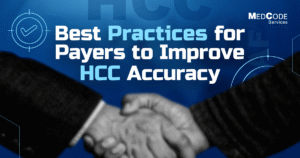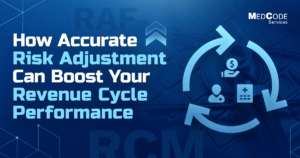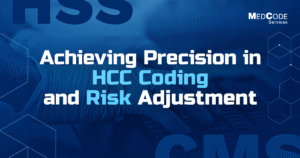In risk-adjusted payment models, every detail matters. Each diagnosis a provider documents adds to the overall financial picture. Missing even a single HCC code doesn’t just impact accuracy; it can completely turn what should have been fully supported care into a revenue loss. For payers, getting coding right is what helps keep reimbursements stable and ensures patients still receive the care they need.
An impactful real-world review uncovered more than $160,000 in potential net gain as a result of closing documentation gaps. This just goes on to reinforce that every uncoded condition chips away at revenue at the bottom line and misrepresents the true health status of a patient.
As value-based payment models replace fee-for-service, one stark truth is clear, which is that Risk Adjustment Factor (RAF) accuracy is no longer an optional choice; it’s a necessity. Capturing the full clinical picture of a patient through comprehensive HCC documentation is essential not just for the purpose of reimbursements but for sustaining high-quality, long-term care.
Impact of HCC Codes on Payer Payments
For payers, HCC coding isn’t just a compliance measure; it’s the element that drives reimbursement.
- RAF Score
- CMS assigns each HCC code a cost weight.
- These weights, when combined with demographic factors such as age, gender, Medicaid status, etc., form a member’s Risk Adjustment Factor (RAF) score.
- CMS assigns each HCC code a cost weight.
- Revenue Link
- Higher RAF scores result in higher payments to cover projected care costs.
- Missing or incomplete HCC codes lead to lower RAF scores, further resulting in underfunding for members with chronic or complex needs.
- Higher RAF scores result in higher payments to cover projected care costs.
- Compliance Exposure
- Unsupported or inaccurate codes inflate RAF scores and trigger audit scrutiny.
- CMS Risk Adjustment Data Validation (RADV) audits quite often result in reclaimed payments when medical records fail to substantiate coded conditions.
- Unsupported or inaccurate codes inflate RAF scores and trigger audit scrutiny.
- Double-Sided Risk
- Under-coding: Lost revenue and limited resources for care delivery.
- Over-coding: Potential penalties, repayments, and reputational harm.
- Under-coding: Lost revenue and limited resources for care delivery.
All of these factors clearly establish how accurate, complete, and well-documented coding is essential to secure fair payments while maintaining audit readiness.
Navigating Audit Pressures With Revenue Optimization
The critical scrutiny faced by health plans from CMS and other regulatory bodies makes compliance an extremely valuable factor in safeguarding revenue.
- Understanding of Audit Triggers: Certain diagnosis codes and high-value conditions attract closer scrutiny, making it necessary to verify whether documentation fully aligns with coding submissions or not.
- Integration of Internal Reviews: Conduct targeted internal audits to identify and catch discrepancies early on and correct them before CMS validation checks.
- Enhance Documentation Practices: Provide focused training that equips providers to capture the right level of clinical detail without any vagueness.
- Centralize Compliance Monitoring: Set up easy-to-track dashboards or alerts in the EMR to catch missing details early, long before claims go out.
- Prioritize Real-Time Collaboration: Have coders and clinicians work together in real time to fix documentation gaps quickly and lower the chances of audits or repayment issues.
When payers adopt these practices, they not only reduce audit exposure but also aid in preserving revenue integrity, ensuring each reimbursement reflects the true complexity of the member population.
Major Barriers to Coding Accuracy
From a payer’s perspective, a couple of stubborn challenges stand in the way of coding precision.
- Incomplete or ambiguous provider notes: When documentation leaves out important clinical details, coders don’t have enough to work with. This often results in legitimate HCCs not getting captured, and revenue taking a hit.
- Lag in EMR data flow: Delays in accessing or updating records disrupt the flow of timely and accurate submissions.
- Fragmented vendor workflow: A lack of smooth integration between payer systems and vendor workflows creates inefficiencies that can end up being extremely costly.
- CMS model revisions: Frequent adjustments to coding requirements demand continuous adaptation and can trip up even experienced teams.
When these obstacles pile up, the damage isn’t just about slower workflows. They end up creating more compliance risk and chipping away at revenue. Over time, accuracy suffers.
HCC Accuracy as a Compliance Imperative
Coding accuracy isn’t just about revenue. For payers, it’s also the first line of protection against audits.
- Data Validation Risk (DVR): Even correctly coded HCCs can fail CMS RADV or OIG audits if documentation is insufficient or lacking in any way.
- Compliance Imperative: Accurate coding in combination with thorough documentation is critical to avoid audit recoupments and penalties.
- Revenue & Risk Link: Ensuring proper documentation reinforces audit readiness while protecting revenue integrity.
Strategic Actions to Secure Revenue and Compliance
For payers, the way forward isn’t just better tech or rigid rules; it’s a mix of data-driven processes and real collaboration with providers.
A few steps that usually make a high impact for payers:
- Incentive-based provider engagement that recognizes and rewards timeliness via detailed documentation
- Utilization of predictive analytics to flag conditions that are likely present but not yet diagnosed, limiting missed HCC opportunities.
- Real-time coding validation seamlessly integrated into claim workflows to catch errors before submission.
- RAF score tracking on a quarterly basis to swiftly detect downward trends and tap into the documentation gaps.
The most effective results often come from blending automation with skilled human oversight. As an efficient partner in HCC coding, MedCode, with its expertise, brings both the technology and human skills needed to sharpen these strategies, ensuring payers capture every valid code and strengthen the link between accurate reporting and optimal reimbursement.
Bridging Provider–Payer Disconnect
One big hurdle in HCC coding is the lack of smooth collaboration between providers and payers, which can lead to the creation of gaps in documentation and missed revenue opportunities.
- Real-Time Collaboration: Coders and clinicians collaborate and work together to resolve documentation gaps before claims submission.
- Shared Dashboards & Alerts: Use simple, shared tools that highlight missing or unclear details early, so teams can fix them before they cause problems.
- Provider Incentives: Give credit or small rewards to providers who document clearly and on time; it keeps accuracy consistent across the board.
- Outcome: Strengthened coding accuracy, reduced audit exposure, and optimized revenue capture.
MedCode, with its expertise, combines technology and human oversight to help payers implement these strategies effectively.
Looking Ahead: Risks and Opportunities
- CMS-HCC v28 changes: New condition categories implies that documentation and coding need to align more closely.
- More RADV audits: Increasing checks raise the cost of unsupported or incorrect codes.
- Growing member complexity: Older populations and patients with multiple chronic conditions make accuracy in coding more critical.
Having knowledge of these trends and staying aware helps payers maintain compliance, secure enhanced revenue, and plan better for long-term growth.
Conclusion
HCC coding isn’t just about rules. It protects money, helps patients, and keeps trust with providers. Every condition recorded correctly means better payments and fewer audit problems.
As regulations change and patients age or deal with more complex health needs, clear coding is more important than ever. MedCode helps payers fix documentation gaps by combining simple tech, hands-on expertise, and analytics. This keeps coding accurate, payments right, and audits less stressful.







